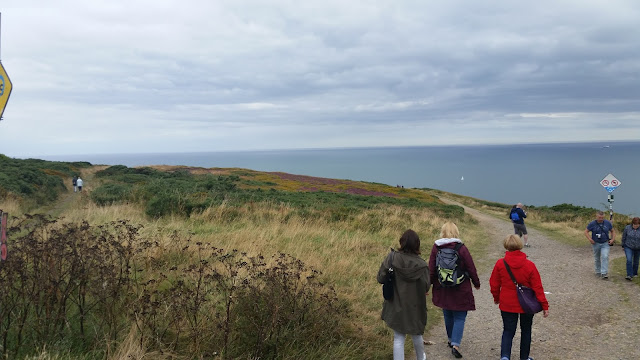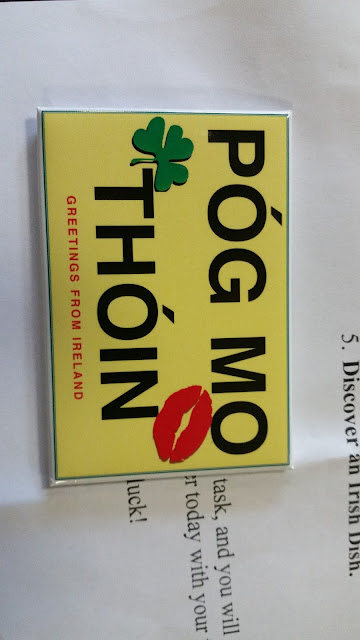After breakfast on Sunday the 14th, about 10:00 the entire Angloville group set off on a day trip to explore. We drove south through Dublin and into the Wicklow Mountains National Park on a very narrow mountain road but with excellent views. Here are a couple of short videos of three of our stops to enjoy the scenery.
After getting through the mountains, we arrived at the Glendalough National Park which includes both the Ecclesiastical Settlement and Monastic Site as well as hiking trails, two lakes and other interesting sites.
At the entrance to the Monastic Site, a woman was playing music on a relative of a bagpipe.
It is called the Irish Uilleann Pipes. While bagpipes require the performer to blow air into them, the Uilleann pipes get air from bellows that are moved with one arm - this means your mouth is free and after I stopped videotaping, the lady began to sing along with the music from the pipes
There were well maintained hiking trails between the different sites in the park.
On Monday the 15th, we did our final speaking sessions before lunch. After lunch, the participants did the oral presentations in English and we finished the program. Tuesday morning, we started saying goodbye to participants, some of whom had flights that morning. Some had flights on Wednesday morning, so they went on a day trip to the Cliffs of Moher. The two Hungarians took it easy until their evening flight home. I went with two Polish participants to visit the Guinness Storehouse. Our time included an introduction, a self guided tour, a lesson on how to pour Guinness from a tap (including a certificate of training), samples of Guinness in the bar and finally a pint of Guinness to enjoy in the circular bar on the 7th floor which allows views of Dublin in all directions. One of the more interesting parts of the museum was the section with a history of Guinness advertising.
I said my final goodbyes back at DCU and then took a taxi to the Clayton Hotel out near the Dublin Airport. I had a pleasant stay there, getting up at 3:40 Wednesday morning, catching a 4:30 shuttle to the airport, then a 7:15 flight to Amsterdam, an 11:05 flight to Chicago (it was nine hours long) and a 4:20 flight to Portland (it was a four hour flight). I finally arrived home about 7:30, some 24 hours after waking up in Dublin.
After getting through the mountains, we arrived at the Glendalough National Park which includes both the Ecclesiastical Settlement and Monastic Site as well as hiking trails, two lakes and other interesting sites.
At the entrance to the Monastic Site, a woman was playing music on a relative of a bagpipe.
It is called the Irish Uilleann Pipes. While bagpipes require the performer to blow air into them, the Uilleann pipes get air from bellows that are moved with one arm - this means your mouth is free and after I stopped videotaping, the lady began to sing along with the music from the pipes
There were well maintained hiking trails between the different sites in the park.
On Monday the 15th, we did our final speaking sessions before lunch. After lunch, the participants did the oral presentations in English and we finished the program. Tuesday morning, we started saying goodbye to participants, some of whom had flights that morning. Some had flights on Wednesday morning, so they went on a day trip to the Cliffs of Moher. The two Hungarians took it easy until their evening flight home. I went with two Polish participants to visit the Guinness Storehouse. Our time included an introduction, a self guided tour, a lesson on how to pour Guinness from a tap (including a certificate of training), samples of Guinness in the bar and finally a pint of Guinness to enjoy in the circular bar on the 7th floor which allows views of Dublin in all directions. One of the more interesting parts of the museum was the section with a history of Guinness advertising.
I said my final goodbyes back at DCU and then took a taxi to the Clayton Hotel out near the Dublin Airport. I had a pleasant stay there, getting up at 3:40 Wednesday morning, catching a 4:30 shuttle to the airport, then a 7:15 flight to Amsterdam, an 11:05 flight to Chicago (it was nine hours long) and a 4:20 flight to Portland (it was a four hour flight). I finally arrived home about 7:30, some 24 hours after waking up in Dublin.









































































